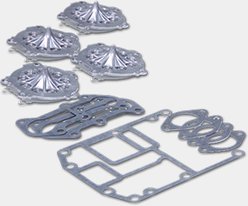
How to Choose the Correct Size Dockline
When you moor your boat, you want to know it’ll be safe and sound, so make sure you pick out the proper dockline.

Peruse the Mercury Dockstore and you’ll find that among the boating accessories and gear you’ll see an assortment of docklines in different diameters and lengths. Since you depend on those lines to keep your pride and joy safe and secure in the slip where it belongs, naturally, you’ll want to be 100% confident that you choose the proper size.
Dockline Size Options
Most boaters will be dealing with boats up to 30 feet in length and therefore choosing between 3/8- and 1/2-inch docklines in lengths of 15 or 20 feet. Lines 3/8 inch in diameter are usually the best pick for boats less than 20 feet long. For larger boats, it’s best to upsize the line diameter by 1/8 inch for each 10 feet of length overall (LOA). So, for a 20- to 30-foot boat, 1/2-inch lines are a good choice. For 30- to 40-foot boats, move up to 5/8-inch lines, and so on.
Some people choose 1/2-inch lines even for a boat less than 20 feet long, working on the assumption that stronger lines will always be better. There’s some value to that thought, but it’s only true to a degree because many boats under 20 feet have relatively small cleats. Try using 1/2-inch lines on them, and you might discover that the thicker lines simply don’t fit. That said, as long as the lines do fit well on the cleats, there’s certainly no harm in going with the thicker, stronger option.
Choosing dockline lengths for wet slips depends a bit on how your slip is set up. In most cases, 15-foot lines are sufficient, but if the boat is kept in a large slip with lots of extra space, you might need 20-foot lines instead. And don’t forget, those lines need some slack to account for tidal swings and/or changing water levels, so you don’t want to be cutting it close on length. Also remember that you’ll want to keep spare docklines in your boat for tying up when you visit a waterfront restaurant or bait shop. In that case, it’s always better to have longer lines, since you never know just what sort of mooring situation you could be in for. And if the thought of docking in an unfamiliar slip gives you pause, check out the Mercury blog “Tips to Dock a Boat the Easy Way” to get the scoop on how to make it happen like a pro.
How Many Docklines Do You Need?
In wet slips, four docklines (two aft and two forward) is generally considered minimum. In areas with tidal swing, also be sure to cross the lines when possible, to provide a longer lead between the piling(s) and the boat. This will make water-level changes less problematic and allow for more stretch in the lines during dramatic tidal swings. In many slips, you might also want to add an additional line or two running from forward and/or aft pilings to amidships spring cleats to help control forward and/or aft motion in the slip.
In temporary mooring situations where you’re tying up to a T-head or alongside a pier, in calm conditions you can likely get away with using just two mooring lines, one fore and one aft. You might also want to add a spring line if there’s another boat tied up in front of or behind yours. This is also a situation where you’ll want to deploy fenders since you won’t have lines on the other side of the boat to prevent it from rubbing up against the pier.
Dockline Types
Some boaters prefer three-strand docklines, while others prefer braid. Each type has its advantages. Three-strand provides more stretch to account for light waves or water-level changes, but braided lines are smoother, look better and remain more pliable with age.
In either case, choosing lines with loops spliced into the end can make mooring easier, especially for boats kept in slips. All you need to do to secure a line with a loop is slide the loop through the center of the cleat and then pull the loop back over the cleat’s horns. And in temporary slips, having a loop spliced in allows you to put the bitter end of the line (the end that connects to the boat) through the loop, and then lasso it over a piling.
One final tip: The first time you tie up a boat in any slip, it’s always a good idea to check on it every few hours as the weather or tidal conditions change. Then you can adjust the lines if need be, and rest assured that your pride and joy is safely tied up right where it belongs.















